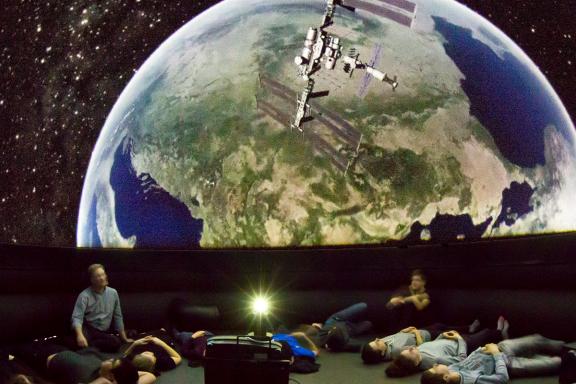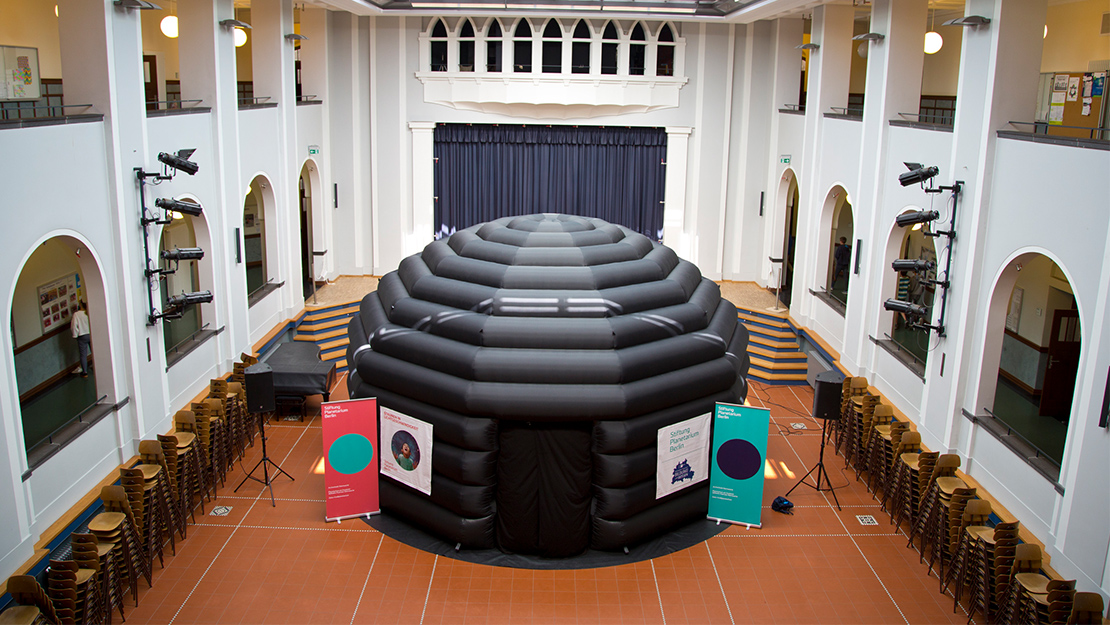
INtense
The mobile science theatre for Berlin schools
INTENSE - The mobile science theatre
INTENSE is the Berlin Planetarium Foundation's mobile planetarium dome that travels through the capital's daycare centers, elementary and high schools and visits students on site. The goal of INTENSE is to awaken and encourage students' interest in the STEM subjects (Science, Technology, Engineering and Math).
The transportable dome has an outer diameter of nine meters and is set up by the INTENSE team in the gymnasium or auditorium of a school. An entire school class can be seated under the dome. A high-resolution projector with special optics displays the content on the domed projection surface without distortion.
Presenters from the INTENSE team provide insights into current findings about astronomy, humankind, nature and technology through interactive dialog with the students.
How can INTENSE visit my school?
In order to set up the mobile planetarium, a floor space of at least 9 m x 9 m and a height of 5 m is required. Access to the assembly hall or sports hall should be at ground level or possible via an elevator with a door width of at least 95 cm. There is also an all-inclusive, one-time booking fee of 400€.
A booking of at least three days is required, as one day is needed for set-up and dismantling. Since the cost (the all-inclusive booking fee) is the same for three, four or five days, we recommend booking INTENSE for the whole week. Within this time, the program can be arranged for one or more classes from our course offerings.
If you are interested in booking INTENSE, please fill out the form that can be downloaded below and send it to bildung@planetarium.berlin.
Download: INTENSE booking form (currently only in German)

Courses
Please allow 45 minutes for the courses. The courses are presented live and offer plenty of room for questions and discussions with the students. We are also happy to respond to your individual suggestions. Just contact us for questions regarding content and organization!
With prior discussion, it is also possible to have a program presented in English.
Spaceship Earth
In this course, students will become familiar with orienting themselves to the current night sky. Heading north from the Big Dipper to Polaris allows us to become more familiar with the northern constellations, their mythology, and then the seasonal constellations. From the earthly view of the sky, we then take a rocket launch into space to view our spaceship Earth from the outside. The students learn about the change of day and night as well as the Earth's annual cycle around the sun. They then take a trip around the Earth with the moon to understand how the phases of the moon are formed. A landing on the moon allows the students to get to know not only the lunar surface with its craters, but also the everyday challenges of the Apollo astronauts. Finally, the 360° projections take us into our solar system and teach the differences in size and speed of the eight planets around the sun.
We recommend this program for grades 1-4.
Rocketship to the Planets
In this course, students embark on a journey to the eight planets of our solar system. After an initial orientation in the current starry sky, they will go to little Mercury and red-hot Venus. Why is Mars red? Is there still water there today? Students will learn the answers by landing on the fourth rocky planet of our solar system! The journey continues to the giant planets: Jupiter with its 79 moons and Saturn with its impressive rings. A detour to the moons will show where there could be places for life in our solar system. Finally, the INTENSE team takes the students to the icy regions of our solar system, where our sun is just a small, bright dot in the sky. Out here, the bluish shimmering ice giant Uranus appears, as well as the eighth planet, Neptune, discovered in Berlin. In the end, we return to the only planet where life exists: our home, Earth.
We recommend this program for grades 2-6.
Mission Mars
The red planet is moving further and further into the focus of humanity. Could Mars become our second home in space? Could we perhaps live there permanently? New rovers, orbiters, and space probes are being sent into space all the time to explore our special neighboring planet. In this program, we take students on a journey to our next-door neighbor using the 360° video projection system. Here we will explain what differences and similarities Mars has compared to Earth. A look into the past will show that this place once had liquid water and all the conditions for the emergence of life. Where the water is today and whether there are traces of life, is being investigated by a wide variety of Mars missions in orbit around and on the planet. We present some of the most current missions and show the challenges of landing on Mars and preparing it for humans to land there in the future.
We recommend this program for grades 4 and up.
Our Blue Planet
What makes our Earth so unique, that life can exist on it? This question is the basis for the exploration of the complex system of our Earth, with the help of current scientific 360° visualizations on the planetarium dome.
Liquid water on our planet creates a complex interplay of water cycles, erosion, weather, and climate that gives rise to a variety of habitats and life forms. Students take a comprehensive look at the state of "System Earth," our ecological impact, and what we can do to keep it from becoming unbalanced. After all, the consequences of this - such as climate change - affect us all.
We recommend this program grades 5 and up.
Space Probes
On October 4, 1957, a satellite was launched into space for the first time: "Sputnik 1. The first satellite marked the beginning of the age of space travel and marked the start of humankind’s endeavors to reach outer space. About 20 years later, the first space probes were sent into the far reaches of space to collect scientific data about the planets, moons, asteroids, and other celestial objects in our solar system. This course is designed to introduce students to the most important missions to the eight planets of the solar system and to show what knowledge we have gained both then and now. We will use the 360° dome projection to travel to the individual planets of the solar system, show historical images of the respective space probes and their first images of the planets.
We recommend this program for grades 5 and up.
Distance in Space
For humans, dealing with distances is an everyday occurrence. It may be a few hundred meters to the nearest bakery, a few kilometers to our grandparents' house, or even one to two thousand kilometers to a vacation destination. In this course, the students get a feeling for the unimaginable dimensions and their measurement in space. During a 360° flight through the solar system, it becomes clear that new units of measurement are needed in addition to kilometers.
Students will learn about the light seconds, light minutes, light hours and even light years that are used to measure the distances in space. On a journey at the speed of faster-than-light, we take students to the edge of our visible universe and share many examples of how long it takes today to cover these distances.
We recommend this program for grades 5 and up.
Life on the ISS
The starting point of our journey into weightlessness is located 400km above the earth: The International Space Station (ISS) orbits around our planet in just 90 minutes and is the largest space laboratory in human history. Since 2000, astronauts have been continuously on board, conducting scientific research in weightlessness. But how does weightlessness actually occur? What does the daily life of astronauts look like at an altitude of 400km and what challenges do even the simplest activities bring with them? In this 360° expedition, students learn about the everyday life of astronauts on the International Space Station.
We recommend this program for grades 5 and up.
Moons in Space
So far, we know of more than 250 moons orbiting the eight planets in our solar system. But what is the difference between moons, planets and stars? While the rocky planets are orbited by only a few of these natural satellites, the large gas planets like Jupiter and Saturn are orbited by more than 70 moons. They consist of thick layers of ice, bubbling volcanoes, or entire lakescapes of methane. In this program, students look at how the many moons of the solar system differ from our Earth's moon and explore the formation of these unique worlds.
We recommend this program for grades 5 and up.